
Mayflies are aquatic insects belonging to the order Ephemeroptera. This order is part of an ancient group of insects termed the Palaeoptera, which also contains dragonflies and damselflies. Over 3,000 species of mayfly are known worldwide, grouped into over 400 genera in 42 families.

Sarcoptes scabiei or the itch mite is a parasitic mite found in all parts of the world that burrows into skin and causes scabies. Humans become infested by Sarcoptes scabiei var. hominis; other mammals can be infested with different varieties of the mite. They include wild and domesticated dogs and cats, ungulates, wild boars, bovids, wombats, koalas, and great apes.

Baetidae is a family of mayflies with about 1000 described species in 110 genera distributed worldwide. These are among the smallest of mayflies, adults rarely exceeding 10 mm in length excluding the two long slender tails and sometimes much smaller, and members of the family are often referred to as small mayflies or small minnow mayflies. Most species have long oval forewings with very few cross veins but the hindwings are usually very small or even absent. The males often have very large eyes, shaped like turrets above the head.
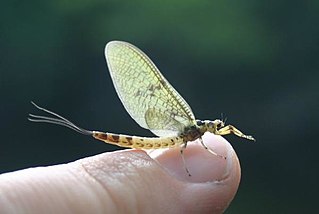
Ephemeridae is a family of mayflies with about 150 described species found throughout the world except Australia and Oceania.

Ephemerellidae are known as the spiny crawler mayflies. They are a family of the order Ephemeroptera. There are eight genera consisting of a total 90 species. They are distributed throughout North America as well as the UK. Their habitat is lotic-erosional, they are found in all sizes of flowing streams on different types of substrates where there is reduced flow. They are even found on the shores of lakes and beaches where there is wave action present. They move by swimming and clinging, they are very well camouflaged. Most species have one generation per year. They are mostly collector-gatherers.
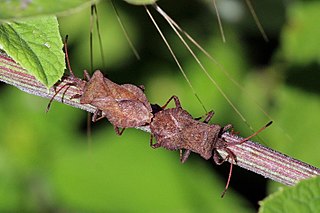
Coreus marginatus is a herbivorous species of true bug in the family Coreidae. It is commonly known as the dock bug as it feeds on the leaves and seeds of docks and sorrels. It is a medium-sized speckled brown insect, between 13 and 15 mm long as an adult, with a broad abdomen. It occurs throughout Europe, Asia and northern Africa. It is often found in dense vegetation, such as hedgerows and wasteland.

Dermacentor andersoni, commonly known as the Rocky Mountain wood tick, is a hard tick, or member of the Ixodidae family, with three life stages including larvae, nymph, and finally adult, or, more entomologically, imago. This tick is generally located in the northwest United States and southwest Canada along the Rocky Mountains. This tick is generally a vector for Colorado tick fever, but can also be a vector for Rocky Mountain spotted fever and tularemia. During the larval and nymphal stages, the tick does not feed on humans, but during the adult stage, it will. Prevention of infections associated with these ticks is based on control of exposure to the vector, including wearing proper clothing when in woods/wet areas, and checking oneself thoroughly after returning home. Adult female ticks can feed for 5 to 15 days, thus removing a tick if present is very important. Follow general tick removal tips.

Ixodes pacificus, the western black-legged tick, is a species of tick found on the western coast of North America. I. pacificus is a member of the family Ixodidae. It is the principal vector of Lyme disease in that region. I. pacificus larvae and nymphs typically feeds on lizards and small mammals, while adults typically feed on deer. It is an ectoparasite that attaches itself to the outside of its host and feeds on the host's blood. It can have a heteroxenous lifestyle or monoxenous life cycle depending on how many hosts it feeds on in each cycle. I. pacificus has a four-stage life cycle that takes around 3 years to complete. These stages include egg, larva, nymph, and adult. They prefer dense woodland habitats or areas of brush and tall grass.
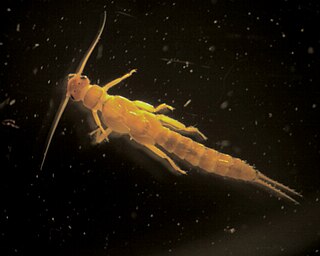
Chloroperlidae are a family of stoneflies, commonly known as green stoneflies, with more than 200 species and 22 genera. They appear green to yellow in colour, and are popularly used among fisherman as bait for trout fishing. Green stoneflies live in the benthic zone of the cold streams and rivers of five continents and four zoogeographical regions, emerging from the water to live in the riparian zone as adults. They are sensitive to pollutants, making them an indicator species for determining the quality of water bodies. Chloroperlidae are hemimetabolous, having no pupal stage, but instead hatch from eggs as nymphs and mature directly into adults. They are omnivorous, feeding on small organisms and plant particles, and become more carnivorous as they mature. The classification of Chloroperlidae is contested, with some believing that they should be considered as members of different orders, as opposed to the order Plecoptera that they currently belong to.
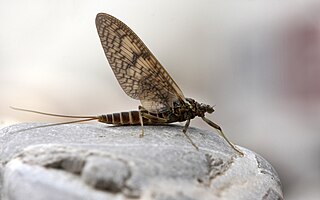
Rhithrogena germanica is a European species of mayfly, and is "probably the most famous of all British mayflies", because of its use in fly fishing. It is known in the British Isles as the March brown mayfly, a name which is used in the United States for a different species, Rhithrogena morrisoni. It emerges as a subimago at the end of winter, and can be distinguished from similar species by a dark spot on the femur of each leg.

Eurygaster maura, also known as tortoise bug, is a species of true bugs or shield-backed bugs belonging to the family Scutelleridae.
Dolania is a monotypic genus of mayfly in the family Behningiidae containing the single species Dolania americana, also known as the American sand-burrowing mayfly. It is found in the southeastern United States, as far south as Florida, and is generally uncommon. The adult insects emerge before dawn in early summer, mate and die within the space of about thirty minutes. The female deposits her eggs in the water and dies within five minutes of emergence. This is believed to be the shortest adult lifespan of any insect.

Ephemera vulgata is a species of mayfly in the genus Ephemera. This mayfly breeds in stationary water in slow rivers and in ponds, the nymphs developing in the mud.
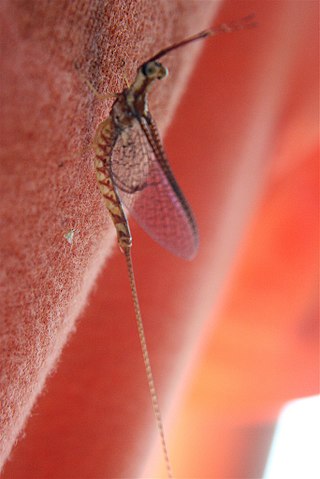
Hexagenia limbata, the giant mayfly, is a species of mayfly in the family Ephemeridae. It is native to North America where it is distributed widely near lakes and slow-moving rivers. The larvae, known as nymphs, are aquatic and burrow in mud and the adult insects have brief lives. They are often referred to as fish flies around the Great Lakes as they tend to cause the areas around water to smell like rotten fish.
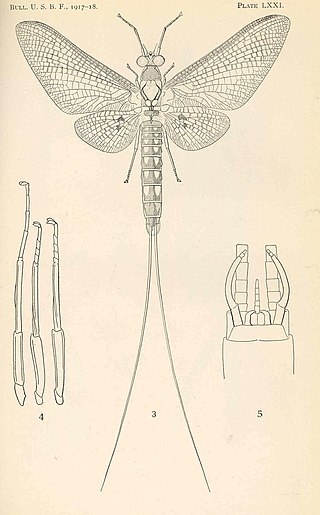
Hexagenia bilineata is a species of mayfly in the family Ephemeridae. It is native to North America where it is found in the Upper Mississippi Valley. Sometimes adults of this mayfly are so abundant as to cause a nuisance because of their enormous numbers. The larvae are aquatic and burrow in mud and the adult insects have brief lives.
Cystidicoloides tenuissima is a species of nematodes in the order Spirurida and family Cystidicolidae. It is a parasite of salmonid fish in the northern hemisphere and has mayflies as the alternate host.

Ephemera guttulata, commonly known as the eastern green drake, shad fly and coffinfly, is a species of mayfly in the genus Ephemera. The eastern green drake is native to the continental United States and Canada. Its conservation status per the NatureServe conservation status ranking system is G5, meaning it is secure.

Ephemera simulans is a species of mayfly. It is commonly found throughout the United States. The species is used for fly fishing.

Paraleptophlebia submarginata is a species of prong-gilled mayfly in the family Leptophlebiidae.
Siphlonisca aerodromia, commonly known as the Tomah mayfly, is an extremely rare species and has only been documented less than 100 times. It was once thought to only known to occur in New York and Northern Maine, but has been since found more recently in eastern Canada as well. The Tomah mayfly is an endangered species and is listed as threatened in both New York and Maine. Its abundance is unknown. The Tomah mayfly is the only species within the monotypic genus Siphlonisca. The Tomah mayfly is a habitat specialist and an indicator species. Adults only live for a few days as they deposit eggs into rivers and streams. Nymphs hatch from eggs and migrate to the floodplains during springtime and following snow melt. They spend most of their lives in the floodplains, feeding on other aquatic invertebrates in order to grow rapidly. The Tomah mayfly was considered as a flagship species and led to the decision not to dam a stream and flood a sedge meadow and therefore conserve the ecosystem.




















